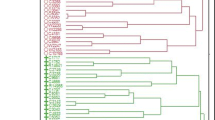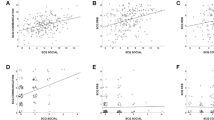Abstract
A questionnaire (the Wing Subgroups Questionnaire, or WSQ) for subclassifying children with autism into one of Wing's three hypothesized subgroups was developed, and the validity of this measure was assessed. Forty parents of children with autism or pervasive developmental disorder not otherwise specified (PDDNOS) completed the questionnaire. Results indicated that the questionnaire has adequate external criterion-referenced validity with similar subgroup ratings made by clinicians, and good internal consistency. Furthermore, results revealed three distinct and separate subgroups corresponding to Wing's subclassification scheme. Other analyses suggested that Wing assignment based on the WSQ was independent of chronological age and age equivalents for social and daily living skills, but not independent of diagnosis of autism vs. PDDNOS, IQ, severity of autism, sex, receptive language mental age, and age equivalents for communication skills. Finally, a discriminant analysis indicated that, of all the dependent variables examined in the present study, the clinicians' Wing assignment was the best predictor of Wing assignment based on the parent-completed WSQ. These findings provide support for Wing's classification system, and suggest that the WSQ is a valid and useful tool for subclassifying individuals with autism.
Similar content being viewed by others
References
American Psychiatric Association. (1987).Diagnostic and statistical manual of mental disorders (3rd ed., rev.). Washington, DC: Author.
Asperger, H. (1944). Die autistischen psychopathen im kendersalter.Archiv fur Psychiatrie und Nervendrankheiten, 117, 76–136.
Bartak, L., & Rutter, M. (1976). Differences between mentally retarded and normally intelligent autistic children.Journal of Autism and Childhood Schizophrenia, 6, 109–120.
Coleman, M. (1987). The search for neurological subgroups in autism. In E. Schopler, & G. Mesibov (eds.),Neurobiological issues in autism (pp. 163–189). New York: Plenum Press.
Dunn, L. M., & Dunn, L. M. (1981).Peabody Picture Vocabulary Test—Revised. Circle Pines, MN: American Guidance Service.
Kanner, L. (1943). Autistic disturbances of affective contact.Nervous Child, 2, 217–250.
Krug, D. A., Arick, J., & Almond, P. (1980). Behavior checklist for identifying severely handicapped individuals with high levels of autistic behavior.Journal of Child Psychology and Psychiatry, 21, 221–229.
Lord, C., & Schopler, E. (1987). Neurobiological implications of sex differences in autism. In E. Schopler & G. B. Mesibov (Eds.),Neurobiological issues in autism (pp. 192–212). New York: Plenum Press.
Mahler, M. S. (1952). On child psychoses and schizophrenia: Autistic and symbiotic infantile psychoses.Psychoanalytic Study of the Child, 7, 286–305.
Rutter, M., & Garmezy, N. (1983). Developmental psychopathology. In E. M. Hetherington (Ed.),Handbook of child psychology (Vol. 4). New York: Wiley.
Sattler, J. M. (1990).Assessment of Children. San Diego, CA: Jerome M. Sattler.
Schopler, E., Reichler, R. J., & Renner, B. R. (1986).The Childhood Autism Rating Scale (CARS) for Diagnostic Screening and Classification of Autism. New York: Irvington.
Sherman, M., Shapiro, T., & Glassman, M. (1983). Play and language in developmentally disordered preschoolers: A new approach to classification.Journal of the American Academy of Child Psychiatry, 22, 511–524.
Siegel, B., Anders, T. F., Ciaranello, R. D., Bienenstock, B., & Kraemer, H. C. (1986). Empirically derived subclassification of the autistic syndrome.Journal of Autism and Developmental Disorders, 16, 275–293.
Sparrow, S., Balla, D., & Cicchetti, D. (1984).Vineland Adaptive Behavior Scales. Circle Pines, MN: American Guidance Service.
Tsai, L. Y. (1987). Pre-, peri-, and neonatal factors in autism. In E. Schopler & G. Mesibov (Eds.),Neurobiological issues in autism (pp. 180–191). New York: Plenum Press.
Volkmar, F. R., Cohen, D. J., Bregman, J. D., Hooks, M. Y., & Stevenson, J. M. (1989). An examination of social subtypologies in autism.Journal of the American Academy of Child and Adolescent Psychology, 28, 82–86.
Volkmar, F. R., Sparrow, S. S., Goudreau, D., Cicchetti, D. V., Paul, R., & Cohen, D. J. (1986). Social deficits in autism: An operational approach using the Vineland Adaptive Behavior Scales.Journal of the American Academy of Child and Adolescent Psychiatry, 26, 156–161.
Wing, L., & Attwood, A. (1987). Syndromes of autism and atypical development. In D. J. Cohen & A. Donnelan (Eds.),Handbook of autism (pp. 3–17). New York: Wiley.
Wing, L., & Gould, J. (1979). Severe impairments of social interaction and associated abnormalities in children: Epidemiology and classification.Journal of Autism and Developmental Disorders, 9, 11–29.
Author information
Authors and Affiliations
Additional information
This article fulfilled part of the first author's requirements for a Master's degree in clinical child psychology at the University of Washington. The authors acknowledge funding from the NINDS (NS26678) awarded to Geraldine Dawson. We gratefully acknowledge the assistance of the parents who participated in this study, as well as the help of Thy Nguyen and Shirley Harrell in the data entry, and of Laura Grofer, Art Lewy, Gary Mesibov, Julie Osterling, and Craig Mason in other aspects of the study's completion.
Rights and permissions
About this article
Cite this article
Castelloe, P., Dawson, G. Subclassification of children with autism and pervasive developmental disorder: A questionnaire based on Wing's Subgrouping scheme. J Autism Dev Disord 23, 229–241 (1993). https://doi.org/10.1007/BF01046217
Issue Date:
DOI: https://doi.org/10.1007/BF01046217




